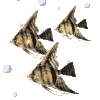|
Having a successful tank is not difficult, or necessarily a lot of work, but only if you use some common sense. These guidelines
are based on science and on experiencecome from aquarists having many years experience of fishkeeping. The following list
summarizes the most important rules for success.
HAVE PATIENCE.
Buying a tank, setting it up and filling it with fish all in the same day will result is dead fish . In fact, setting
up and fully stocking your first tank will take close to a
month!
Firstly you need to choose what kind of tank you want. You are better of choosing a fish tank on what kind of fish
you want, because often people buy tanks and realize that that can't put one of these is a tank that small, so it is best
to research the fish first(this can be done here on stuff and on more specalist websites). In my opinion the best starter
tank size it about 12 US Gallons(50litres). When buying a tank buy a starter tank, because it will save money. A starter tank
is basicly a tank that comes with everything you need-heater, light, filter, aerator, gravel, stand and a hood, some also
come with ornaments and platic plants-that are all made to mesure. If you have a lack of plugs in your house you should use
a thermofilter, which does the job of three plugs(heating, filteration and aeration) in one. There are two main filters that
can be bought an under gravel heater which uses the gravel to filter and a sponge filter that is much more effective and keeps
your water clearer.
Next is setting up the tank first(suprise-surprise)fill the tank with water. For now there is nothing you need to do
with it other that not let it get to full. Then wash all equiptment and add the filter on the bottom if a under gravel or
attach the suckers to the side of the tank, along with the heater and adjust it to the required tempariture. Now add the gravel
and bury the end of the aeration tube with a air stone in a corner, or for a more decorative look buy a long air stone and
bury it alonge the back of the tank. Now all thats left are the plants and decorations, these can be added where ever you
think they should aslong as they arn't at risk of falling and killing your fish. REMEMBER Do Not Put Your Hand In The Water
While Eletrical Equiptment Is Plugged In.
Now leave your tank without a lid for at least three days for clorine(that is added to our tap water to keep it clean
but its poisonous to fish) to evaporate. From now on comes the tricky part of fish keeping-->chemistry. There are three
main parameters to worry about. First-pH(mesured in a range of colour1-14, 1 being acidic and 14 beind alkaline), the pH of
the water defines how asidicor alkaline it is. Most fish like the water at pH7 or neutral, but there are some that like it
slitly acidic or alkaline. To find out the pH of your water you can buy various tests from fish shops that are quite cheap.
If you find your pH high or low pH adjusters can be bought. Second-Hardness(mesured in dh), the hardness of your water consists
of the amount of carbon and magneisium ions, if there are a lot then its hard if there is a small amount it is soft. The hardess
isn't very important but if your fish prefere hard water and you have soft they might not be as active or more prone to disiese.
Again there are various test you can buy to fing out your water hardness or you can ring your local water board to find out.
If you find your dh not ideal for your fish there ways to change it but is best left as violent swings it water chemistry
can kill fish and it can cause the pH nubers to move(violent swings in the pH can kill fish but the pH adjusters are USALY
safe as they build it up/down slowly). Third is the most important to you now-ammonia, nitrites and nitrates(mesured in mg),
basicly these are created by rotting excrete but are deadly to fish. You can get tests cheap at a fish shop but there is no
way to manualy get rid of it. This is where the cycling of water comes into it, the water cycle is very complicated but its
made up of four chemicals- amonnia the first stage of bacteria then comes and eats it and deposites, nitrites which get eaten
by it's own bacteria that excretes nitrates which arn't toxic to fish. This cycle begings when your fish are added and lasts
for about a month.
The first fish you buy should be quite cheap or hardy as they then less likely to die and if they do it's not to much
loss.
|

